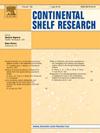长江、黄河中硅、碳与颗粒物的相互作用及变异
IF 2.2
3区 地球科学
Q2 OCEANOGRAPHY
引用次数: 0
摘要
硅和碳(Si-C)相互关联的生物地球化学循环对水生生态系统的有效运作至关重要。然而,在河流系统中Si-C定量输运动力学的方法学研究方面存在显著的差距。研究了长江、黄河流域Si-C的时空变化特征、来源及输出机制。我们的研究结果表明,生物源二氧化硅(BSi)浓度受到大坝运行的显著影响,而溶解硅酸盐(DSi)浓度在下游表现出适度的下降。此外,与悬浮颗粒物(SPM)相关的BSi与SPM浓度呈反比关系。颗粒物有机碳(POC)主要来源于陆生C3植物,而在黄河,C4植物的贡献更大。POC与氮的化学计量比(C/Nbulk)和BSi的变化表明,河流运输过程中的碳降解比河口环境中更为明显。此外,与BSi相关的δ13C (δ13CBSi)相比,河流整体POC (δ13Cbulk)的δ13C对环境变化的敏感性更强。我们提出了一种基于归一化的方法来评估河流系统中与BSi相关的POC和有机碳的潜在衰减率。碳更容易从颗粒物质中矿化,而不是从与硅相关的物质中矿化,并且耦合的Si-C动力学可以用来探索它们的差异行为和硅在碳保存中的作用。该研究为河流-河口系统的Si-C动力学提供了有价值的见解,特别是在人类活动影响日益增加的情况下。本文章由计算机程序翻译,如有差异,请以英文原文为准。
Interaction and variability of silicon and carbon associated with particulate matter in the Changjiang and Yellow Rivers
The interrelated biogeochemical cycles of silicon and carbon (Si-C) are essential for the effective functioning of aquatic ecosystems. However, there exists a notable gap in methodological research addressing the quantitative transport dynamics of Si-C within riverine systems. This study examines the spatiotemporal variations, sources, and export mechanisms of Si-C in the Changjiang and Yellow Rivers. Our results reveal that biogenic silica (BSi) concentrations are significantly affected by dam operations, while dissolved silicate (DSi) concentrations exhibit a modest downstream decline. Moreover, BSi associated with suspended particulate matter (SPM) shows an inverse relationship with SPM concentration. Particulate organic carbon (POC) in the Changjiang River predominantly originates from terrestrial C3 plants, whereas in the Yellow River, there is a greater contribution from C4 plants. Variations in the stoichiometric ratios of POC to nitrogen (C/Nbulk) and BSi suggest that carbon degradation during river transport is more pronounced than in estuarine environments. Additionally, the δ13C of bulk POC (δ13Cbulk) in the river exhibits greater sensitivity to environmental changes compared to the δ13C associated with BSi (δ13CBSi). We propose a normalization-based methodology to assess the potential decay rates of POC and organic carbon associated with BSi within river systems. Carbon is more readily mineralized from particulate matter than from that associated with silicon, and the coupled Si-C dynamics can be employed to explore their differential behaviors and the role of silicon in carbon preservation. This study provides valuable insights into Si-C dynamics in river-estuary systems, particularly under the increasing influence of anthropogenic activities.
求助全文
通过发布文献求助,成功后即可免费获取论文全文。
去求助
来源期刊

Continental Shelf Research
地学-海洋学
CiteScore
4.30
自引率
4.30%
发文量
136
审稿时长
6.1 months
期刊介绍:
Continental Shelf Research publishes articles dealing with the biological, chemical, geological and physical oceanography of the shallow marine environment, from coastal and estuarine waters out to the shelf break. The continental shelf is a critical environment within the land-ocean continuum, and many processes, functions and problems in the continental shelf are driven by terrestrial inputs transported through the rivers and estuaries to the coastal and continental shelf areas. Manuscripts that deal with these topics must make a clear link to the continental shelf. Examples of research areas include:
Physical sedimentology and geomorphology
Geochemistry of the coastal ocean (inorganic and organic)
Marine environment and anthropogenic effects
Interaction of physical dynamics with natural and manmade shoreline features
Benthic, phytoplankton and zooplankton ecology
Coastal water and sediment quality, and ecosystem health
Benthic-pelagic coupling (physical and biogeochemical)
Interactions between physical dynamics (waves, currents, mixing, etc.) and biogeochemical cycles
Estuarine, coastal and shelf sea modelling and process studies.
 求助内容:
求助内容: 应助结果提醒方式:
应助结果提醒方式:


